With the division of Germany in the aftermath of World War II into Soviet controlled East Germany and West Germany, which was supported by Great Britian, France and the United States, on October 7, 1949, it necessitated separate national hockey team programs.
Thursday, October 3, 2013
1988 East Germany Andreas Ludwig Jersey
After the fall of the Berlin Wall on November 9, 1989, the German Democratic Republic (East Germany) and the Federal Republic of Germany (West Germany) once again became a single, united country for the first time since 1949 with their official reunification on October 3, 1990.
With the division of Germany in the aftermath of World War II into Soviet controlled East Germany and West Germany, which was supported by Great Britian, France and the United States, on October 7, 1949, it necessitated separate national hockey team programs.
With the division of Germany in the aftermath of World War II into Soviet controlled East Germany and West Germany, which was supported by Great Britian, France and the United States, on October 7, 1949, it necessitated separate national hockey team programs.
The flag of the German Democratic Republic,
otherwise known as East Germany
The East Germans made their international debut on January 28, 1951 in a 8-3 loss to Poland. It would take them until 1956 to make their debut at the World Championships, which they did in style, winning the "B" Pool tournament to earn promotion to the Top Division their first time out.
The East Germans were also represented at the 1956 Olympics by the Unified Team of Germany, a single team of athletes which competed at the Summer and Winter Olympics in 1956. However, in the case of the Winter Olympic hockey tournament, the East German and West German teams were not combined into a single representative team, but instead the two sides faced off against each other prior to the Olympics to determine which one team would represent Germany as a whole, so rather than being a unified team, it served the opposite effect in the case of hockey, pitting the two sides against each other!
For 1956, the West Germans won 7-3, leaving the East Germans out of the Games.
In 1957, the World Championships were held in the Soviet Union for the first time, and due to the Soviets occupying Hungary at the time, the United States, Canada, Norway, West Germany, Switzerland and Italy all stayed home in protest. With the lack of several of the favorites, East Germany was able to finish 5th thanks to wins over Japan, Poland and Austria.
Despite their success in 1957, they did not participate in the 1958 World Championships, but returned in 1959 for a 9th place finish. After being drubbed by the Soviet Union, the United States and Norway in the First Round, being outscored 21-6, they held their own in the Consolation Round, beating Poland 5-1, Switzerland 8-0 and Italy 8-6, but lost to West Germany and Norway for a second time.
East Germany was again represented by the Unified Team of Germany at the 1960 Olympics, only as in 1956, the West Germans prevailed in the qualification matches by scores of 5-2 and 5-3 and won the right to represent Germany as a whole.
After not participating in 1961 or 1962, the East Germans became regulars at the World Championships from 1963 on. Facing the might of the hockey powers of the world, the East Germans finished 6th (with a win over Finland and a tie against the United States) in 1963.
East Germany vs Czechoslovakia in 1963
The following year was another Olympic year, and East Germany was again represented by the Unified Team of Germany, but for a third time it was the West Germans who won the right to participate following a 4-3 win in their second game after a 4-4 tie in the first game gave the East Germans hope of participating in the Olympics for the first time.
East Germany next placed 5th (With wins over the United States, Norway and Finland) in the 1965 World Championships, 5th (with wins over Sweden (despite giving up 74 shots on goal!), Poland and Finland) in 1966 and 7th (with a win over West Germany and a tie with the United States) in 1967.
East Germany scoring against Sweden in 1965
For the 1968 Olympics, both East and West Germany competed as separate nations for the first time since the division of Germany. While they had met several times during the World Championships, this would be the only time the two nations would face each other at the Olympics, with the West prevailing by a score of 4-2.
East Germany in their only Olympic meeting against West Germany in 1968
With that loss, the East Germans finished in last place with an 0-7-0 record at the Olympics (which also served as the World Championships in Olympic years) and were relegated to Group B for the 1969 World Championships.
East Germany, wearing red instead of their customary blue,
faces Sweden at the 1968 Olympics
It was at this point in 1969, following their failure at the Olympics, that the East German authorities examined their national sporting programs, with a focus on maximizing their greatest return on investment, with their main focus being winning medals at the Summer and Winter Olympics.
As a result of this scrutiny, it was determined that the country should focus on individual sports, as a single track and field athlete, swimmer or speed skater could produce multiple gold medals at the Olympics, while team sports like water polo or ice hockey required many players, special facilities (such as pools and skating rinks) and special equipment (much of which needed to be imported), all resulting in higher operating costs - and all for the sake of hoping to win just a single medal, which seemed unlikely for the hockey program in the face of dominant competition from the Soviet Union, Canada, Czechoslovakia and Sweden.
This thinking, called the Lestungssportbeschluss Directive, resulted in ice hockey being relegated to "Sport 2" status by the East German sports federation, which resulted in East Germany never appearing in another Olympic hockey tournament and the immediate reduction in funding for it's domestic hockey league, which was left with only two clubs, SC Dynamo Berlin and SG Dynamo Weisswasser, to produce top level players for the East German National Team from 1971 on, with those two clubs only being spared because the head of the East German secret police, the Stasi, being an avid hockey fan.
In the 1969 World Championships B Pool, East Germany dominated with a perfect 7-0 record, defeating Poland, Yugoslavia, West Germany, Norway, Romania, Austria and Italy, scoring 11 goals three times and 13 once on their way to a final 62-13 goal differential, which saw them promoted back to the "A" Pool for 1970.
Back in the A Pool in 1970, they found the going much tougher, as they went 2-7-1, managing wins over Finland and Poland as well as a tie with Poland in their other meeting.
For 1971, the East Germans declined to participate in Pool A, and instead competed in Pool B, where they finished 3rd with a competitive 5-2-0 record. In 1972, the World Championships began to be held every year, regardless of it being an Olympic year. Still in Pool B, the East Germans again placed 3rd from a 4-2-0 mark.
As a result of the decision to reduce ice hockey to Class 2 status, the East Germans declined to send a team to the 1972 Olympic games, and would never again compete in the Winter Olympic hockey tournament.
The 1973 World Championship tournament saw the East Germans rise to the challenge despite the lack of support from their own government, waltzing to a 7-0 record with wins over the United States, Yugoslavia, Romania, Austria, Japan, Switzerland and Italy. Almost in spite of themselves, they were again headed back to the A Pool!
Once more swimming with the sharks proved difficult, and East Germany went 1-8-1, defeating Poland 5-3 in their first meeting and playing to a 3-3 tie in their second game of the double round robin schedule. Unfortunately for the East Germans, Poland managed two ties, their other coming against Finland, and the Poles were awarded a 5-0 win over Sweden when Swedish player Ulf Nilsson tested positive for a banned substance after Sweden had won easily by a score of 4-1. The 2 points Poland received in the standings was enough to leap them over East Germany, despite not having beaten them on the ice, resulting in the East Germans being relegated back to Pool B for 1975.
East Germany facing the Soviet Union in 1974
This began a series of promotions and relegations for the East Germans, as they were in the no man's land of international hockey, too good for the B Pool and not strong enough to survive in Pool A. They won the B Pool in 1975 with a 6-1 record, scoring 41 and giving up just 18 in 7 games to gain promotion back to the A Pool for 1976, where they were relegated after a 2-7-1 mark after losing Consolation Round games to Poland and Finland along with a tie against West Germany.
Back in Pool B for 1977, they were once again the dominant side, breezing to a 8-0 record while outscoring the competition 57-16, which only set themselves up for relegation from the A Pool in 1978 when they again faltered in the Consolation Round with ties against West Germany and the Untied States and a loss to Finland sealing their fate yet again.
A new format of play in 1979 saw them win Group 1 easily with a 4-0 mark, but a one goal loss to the Netherlands saw them miss out on promotion back to Pool A for 1981, as the World Championships were not held in 1980 due to the Olympics, which did not count as the World Championships as they had from 1924-1968.
The East German National Team in 1979
A down performance in 1981 saw the East Germans place 4th with a 4-2-1 record but they were again on top of the B Pool in 1982, defeating Norway 10-1 and China 13-7 on their way to a 6-0-1 record to earn their sixth promotion to the A Pool.
Wins over Italy and Finland in the First Round and again in the Consolation Round were enough to ensure their survival in the A Pool for consecutive tournaments for the first time since 1966, again, this coming from a country whose top national league consisted of a mere two clubs to draw national team players from.
Their participation in Pool A for a second consecutive time would have to wait until 1985, as 1984 was an Olympic year.
The 1985 World Championships were the East Germans last hurrah, as they only managed a pair of ties against Finland and the United States, sending them back down to the B Pool, where they would play out the remainder of their days as a separate nation, with a 3rd place finish in 1986 and 5th place finishes in 1987, 1989 and 1990.
The East German National Team at the 1985 World Championships
With East and West Germany reunited in time for the 1991 World Championships, only two players from East Germany would be picked to represent the reunified German National Team, goaltender Rene Bielke and forward Mario Naster. No players from the former East Germany were members of the 1992 Olympic team, but two defensemen from the East, Torsten Kienass and Jorg Handrick would dress for Germany at the 1994 Olympics.
Today's featured jersey is a 1988 East Germany Andreas Ludwig jersey. While West Germany's jerseys were based on the red, black and yellow colors of the German flag, and unlike many of the communist teams who wore red jerseys (the Soviet Union, Czechoslovakia, Poland), the East Germans wore the surprising color combination of blue accented with red and white for most of their existence.
Today's featured jersey is one of the earliest examples of a jersey made by the Finnish company Tackla, as evidenced by the choice of font for the numbers, which would soon change to a block front with a 3-D drop shadow for the remainder of their time as supplier to the IIHF.
Of note, the "DDR" initials on the front of their jerseys stands for Deutsche Demokratische Republik, which translates to German Democratic Republic, often abbreviated as GDR in English.
photo courtesy of Classic Auctions
Bonus jersey: Today's bonus jersey is a 1989 East Germany Jens Feller jersey as worn during the 1989 World Championships B Pool. This jersey was worn in the 1989 World Championships B Pool, Feller's only appearance for the East German National Team.
This jersey has an extremely minimalist style, with only simple striping on the arms and waist and is devoid of any traditional main cresting, with only the Tackla branding on the upper right chest and the DDR initials and East German coat of arms on the left chest in the style of a soccer jersey, leaving the rest of the body devoid of any traditional main logo.
Today's video section contains footage from the 1985 World Championships, where the East Germans faced off against Czechoslovakia, with the East Germans wearing red for one of the few times in their history.
Labels:
East Germany,
Germany
Subscribe to:
Post Comments (Atom)

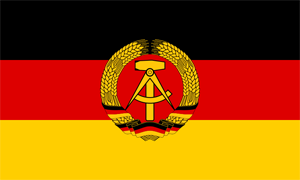


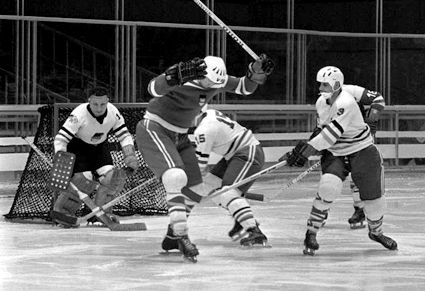
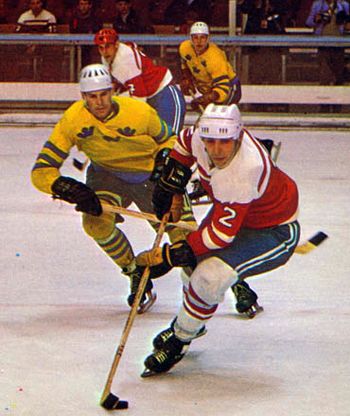

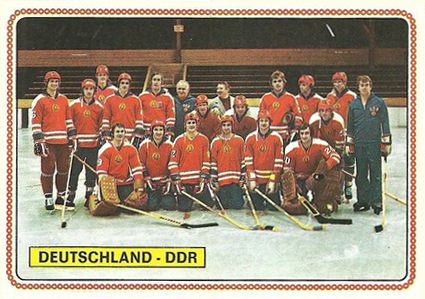
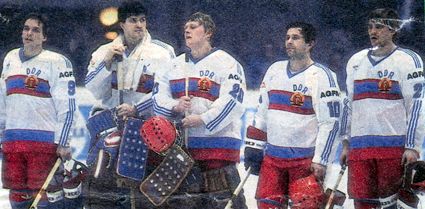
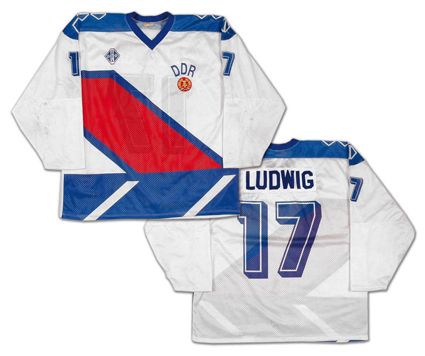
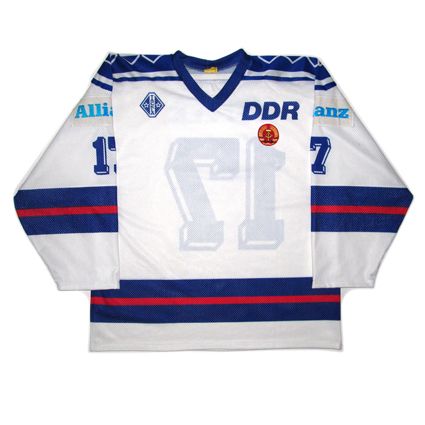
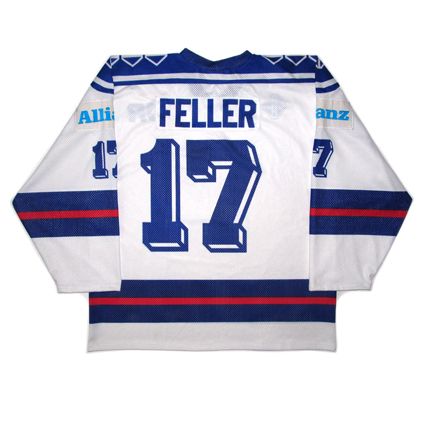










No comments:
Post a Comment
We welcome and encourage genuine comments and corrections from our readers. Please no spam. It will not be approved and never seen.